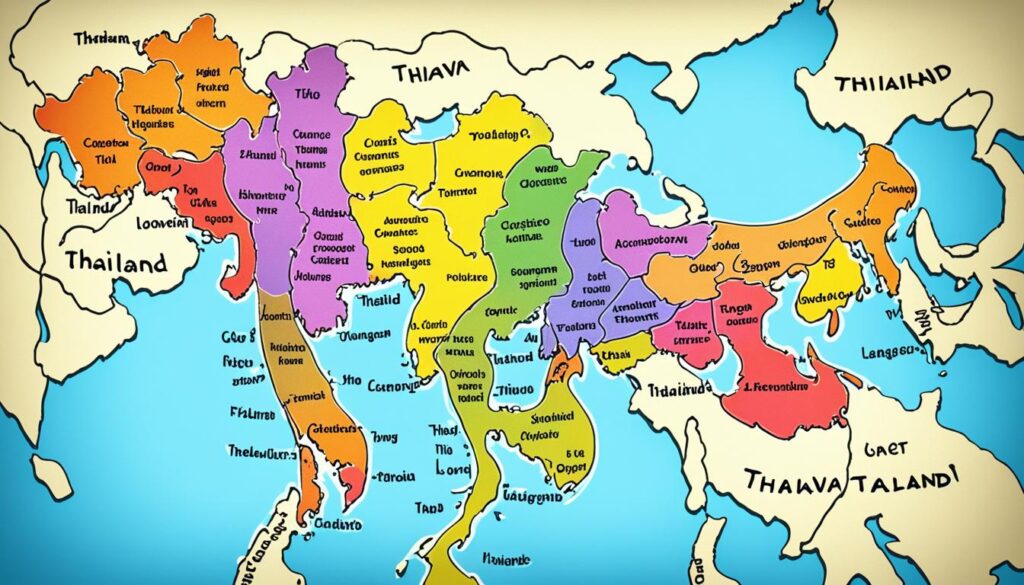Did you know that the Thavung language, also known as Aheu, is spoken by indigenous communities in Laos and Thailand? With an estimated 1,770 speakers in Laos and an additional 750 speakers in Thailand, the Thavung language holds a unique place in the cultural tapestry of Southeast Asia. This fascinating language, belonging to the Vietic branch of the Austroasiatic language family, is renowned for its distinct phonological characteristics and rich linguistic heritage.
In this article, we will delve into the intricacies of the Thavung language, exploring its structure, dialects, development, and preservation. Join us as we uncover the beauty and significance of this language that plays an essential role in the lives of the Phon Sung people. Discover the linguistic features, regional variations, and ongoing efforts to celebrate and protect the Thavung language for future generations.
Thavung Language Structure
The Thavung language is characterized by its unique phonological structure, which includes a diverse inventory of consonants and vowels, as well as diphthongs. These linguistic elements contribute to the distinctiveness of the Thavung language and provide insights into its phonology, consonant and vowel systems, and diphthong usage.
The Thavung language boasts a wide range of consonant sounds, including labial, alveolar, palatal, velar, and glottal consonants. It encompasses nasal, stop, fricative, approximant, and trill consonant types, creating a rich and varied soundscape for Thavung speakers.
In addition to its consonants, the Thavung language features a diverse set of vowel sounds. These include front, central, and back vowel phonemes, offering a broad spectrum of speech sounds for language users to express themselves effectively.
Furthermore, Thavung incorporates diphthongs, which are combinations of two vowel sounds pronounced as a single syllable. Notable examples of Thavung diphthongs include “ia”, “ɨa”, and “ua”. These diphthongs add further complexity and nuance to the language’s phonological structure, contributing to its distinctive character.
By studying Thavung phonology and exploring its consonants, vowels, and diphthongs, linguists gain valuable insights into the linguistic richness and complexity of the Thavung language. Understanding the intricacies of Thavung language structure enhances our appreciation for the unique features of this indigenous language.
Thavung Phonological Elements
| Phonological Feature | Description |
|---|---|
| Consonants | Thavung incorporates a variety of consonant sounds, including labial, alveolar, palatal, velar, and glottal consonants. These sounds range from nasals to stops, fricatives, approximants, and trills. |
| Vowels | Thavung comprises a wide range of vowel sounds, including front, central, and back vowels. This diverse vowel system allows for expressive and nuanced spoken communication. |
| Diphthongs | Thavung incorporates diphthongs, which are combinations of two vowel sounds pronounced as a single syllable. Notable examples include “ia”, “ɨa”, and “ua”. |
Thavung Dialects
Within the Thavung language, various dialects and regional differences exist among different communities. These dialectal variations contribute to the richness and diversity of the Thavung linguistic heritage, showcasing the intricate complexities of the language.
Thavung dialects can exhibit notable differences in pronunciation, vocabulary, and grammar. While the Thavung language is primarily spoken by the Phon Sung people, the distinct dialects emerge due to geographical and historical factors, further shaping the linguistic landscape of the Thavung community.
These regional variations provide fascinating insights into the evolution and development of the Thavung language within specific localities. From intonation and accent discrepancies to distinct lexicons and unique grammatical structures, Thavung dialects offer a deeper understanding of the language’s evolution and its adaptation to different regional contexts.
“The Thavung dialects mirror the diverse cultural and historical backgrounds of the communities where they are spoken. By exploring these subtle linguistic variations, we gain a deeper appreciation of the rich tapestry of the Thavung language.”
As the Thavung dialects continue to be spoken and passed down through generations, they play a crucial role in preserving and promoting the Thavung linguistic heritage. The existence of these dialects reinforces the sense of community and identity among Thavung speakers, strengthening their cultural ties and fostering a sense of pride in their linguistic heritage.
Understanding and documenting the variations among Thavung dialects is essential for the comprehensive preservation and revitalization of the Thavung language. Linguists, researchers, and community members collaborate to study and analyze these dialectal differences, ensuring that they are properly documented and celebrated.

Examples of Thavung Dialectal Variations
| Dialect | Pronunciation | Vocabulary | Grammar |
|---|---|---|---|
| Central Thavung | Distinct intonation patterns and vowel shifts | Some unique words and phrases specific to central region | Use of different sentence structures in certain contexts |
| Northern Thavung | Slower tempo and softer pronunciation | Incorporation of loanwords from neighboring languages | Usage of specific verb conjugations not found in other dialects |
| Southern Thavung | Distinctive nasalized vowels and consonant sounds | Unique terminology related to local customs and traditions | Slight variations in word order and sentence structure |
Thavung Language Development
Efforts towards the development, documentation, and revitalization of the Thavung language have been underway. Linguists and researchers have dedicated their work to create comprehensive resources that document the vocabulary, grammar, and cultural context of the Thavung language.
These initiatives are driven by the objective to preserve and revitalize the language for the long term, safeguarding it against the risks of endangerment and loss. The endeavor involves language development programs and community engagement activities to reinforce Thavung language pride and encourage its continued use.
“The preservation of endangered languages is not only a matter of linguistic diversity but also an essential part of cultural heritage. By documenting and revitalizing the Thavung language, we are preserving a tangible link to the identity and history of the Phon Sung people.”
– Dr. Li Mei, Linguistics Researcher
Language documentation projects play a pivotal role in collecting and preserving the linguistic knowledge of Thavung, ensuring that it is passed down to future generations. These efforts go beyond linguistic aspects by capturing the cultural nuances and unique expressions embedded within the Thavung language.
Through the comprehensive documentation of the Thavung language, researchers provide invaluable resources for language learners, educators, and community members. These resources include dictionaries, grammatical descriptions, and recordings that facilitate language learning, linguistic research, and cultural exploration.
In addition to documentation, Thavung language revitalization efforts encompass a range of activities, such as language immersion programs, community language schools, and the creation of multimedia materials like storybooks and audiovisual resources. These initiatives aim to make the language more accessible, engaging, and relevant to Thavung speakers of all ages.
Current Thavung Language Development Projects
| Project Name | Objective | Location |
|---|---|---|
| Thavung Language Documentation Project | To create a comprehensive linguistic resource for Thavung | Laos and Thailand |
| Thavung Language Revitalization Program | To promote Thavung language use and pride | Song Dao District, Sakon Nakhon Province, Thailand |
| Thavung Cultural Heritage Initiative | To integrate language preservation with cultural festivities | Khamkeut District, Laos |
These collective efforts in Thavung language development provide a foundation for linguistic sustainability and cultural preservation. The ongoing dedication to the Thavung language ensures that its beauty, intricacies, and significance remain alive and thriving within the Phon Sung community.
Thavung Language Preservation
The preservation of the Thavung language is essential for safeguarding its rich cultural heritage and ensuring its revitalization for future generations. Various strategies and initiatives have been implemented to promote Thavung language preservation and revitalization:
Promoting Thavung Language Education
One of the key efforts in language preservation is the promotion of Thavung language education in schools and communities. By incorporating Thavung language classes into the curriculum, children have the opportunity to learn, speak, and write in their native language. This fosters a sense of pride and connection to their cultural roots.
Organizing Language Revitalization Programs
Language revitalization programs play a crucial role in maintaining and reviving Thavung as a living language. These programs include language workshops, immersion camps, and cultural exchange activities. Through these initiatives, Thavung speakers can come together, practice the language, and pass it on to future generations.
Creating Thavung Language Materials
To support language preservation efforts, the creation of Thavung language materials such as textbooks, dictionaries, and literacy resources is vital. These resources serve as valuable tools for Thavung language learners, enabling them to expand their vocabulary, understand grammar rules, and enhance their overall language proficiency.
Celebrating Thavung Culture and Heritage
Cultural events, festivals, and community gatherings provide a platform for the Thavung people to showcase and celebrate their language and heritage. These occasions foster a sense of identity, pride, and unity within the community, encouraging the continued use and preservation of the Thavung language.

| Strategies | Description |
|---|---|
| Promoting Thavung Language Education | Incorporating Thavung language classes into the curriculum, allowing children to learn, speak, and write in their native language. |
| Organizing Language Revitalization Programs | Conducting language workshops, immersion camps, and cultural exchange activities to practice and pass on the Thavung language. |
| Creating Thavung Language Materials | Developing textbooks, dictionaries, and literacy resources to support Thavung language learners. |
| Celebrating Thavung Culture and Heritage | Organizing cultural events, festivals, and community gatherings that showcase and celebrate the Thavung language and heritage. |
Conclusion
The Thavung language, an integral part of the linguistic and cultural heritage of the Phon Sung people, holds immense significance. Efforts to document, preserve, and revitalize the language are crucial for future generations. With its rich linguistic features, diverse dialectal variations, and unique phonological characteristics, the Thavung language is a valuable asset that deserves to be celebrated and protected.
Language development programs and community engagement play a pivotal role in ensuring the continued growth and prosperity of the Thavung language. By supporting these initiatives, we can empower the Phon Sung community to embrace and transmit their linguistic heritage to future generations.
Thavung language preservation is essential not only for the Phon Sung people but also for the broader cultural landscape of Thailand. With continued efforts, Thavung can thrive as a source of pride and identity, contributing to the linguistic diversity and richness of the country. Let us recognize and cherish the Thavung language as a precious cultural treasure of Thailand, securing its legacy for years to come.
FAQ
What is Thavung Language?
Thavung, also known as Aheu, is an indigenous language spoken by the Phon Sung people in Laos and Thailand.
How many Thavung speakers are there?
It is estimated that there are approximately 1,770 speakers in Laos and an additional 750 speakers in Thailand.
What are the unique phonological characteristics of Thavung?
Thavung has a four-way distinction between clear and breathy phonation combined with glottalized final consonants.
Are there variations in the Thavung language?
Yes, there are variations and dialects among different Thavung communities, which can exhibit differences in pronunciation, vocabulary, and grammar.
How is the Thavung language being preserved?
Efforts to document and preserve the Thavung language include language documentation projects, language development programs, and community engagement activities.
What initiatives are involved in Thavung language preservation?
Initiatives include promoting Thavung language education, organizing language revitalization programs, and creating Thavung language materials such as textbooks and dictionaries.
Why is Thavung language preservation important?
Thavung language preservation is crucial to protect the linguistic and cultural heritage of the Phon Sung community and ensure the language’s long-term survival.
